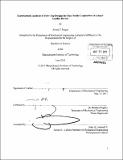Experimental analysis of stove top designs for pine needle combustion in a semi-gasifier burner
Author(s)
Roqué, Alyssa J
DownloadFull printable version (10.89Mb)
Other Contributors
Massachusetts Institute of Technology. Dept. of Mechanical Engineering.
Advisor
Barbara Hughey.
Terms of use
Metadata
Show full item recordAbstract
The motivation behind this project was to develop a better understanding of the role that the stove top plays in a stove where pine needles are the main fuel source. Pine needles have distinct characteristics in their combustion cycle that make it challenging to effectively harness the energy released for cooking purposes. Processed pine needles are currently used as a fuel source, but in areas where the process of turning raw pine needles into another fuel form is not feasible, the use of unprocessed pine needles as a fuel source is required. Two stove top configurations, a spiral and C-shape configuration, were designed and tested in a semi-gasifier system under forced convection. Measurements of operating temperature at various locations for each stove top design indicated that the C-shape design was best at distributing heat more evenly throughout the stove top, which is desirable when cooking, even though it consumed slightly more fuel than the spiral design. The findings of this report can be used as a benchmark prototype for larger-scale stove tops as well as for stoves that need to have passive airflow and non-automated feeding systems.
Description
Thesis (S.B.)--Massachusetts Institute of Technology, Dept. of Mechanical Engineering, 2011. Cataloged from PDF version of thesis. Includes bibliographical references (p. 32).
Date issued
2011Department
Massachusetts Institute of Technology. Department of Mechanical EngineeringPublisher
Massachusetts Institute of Technology
Keywords
Mechanical Engineering.